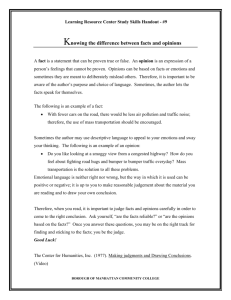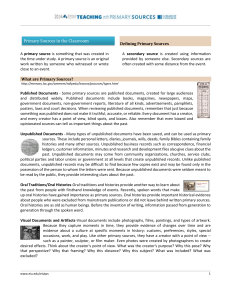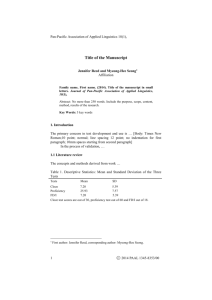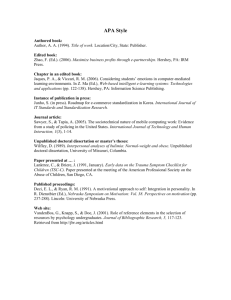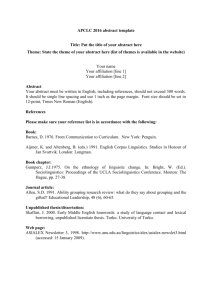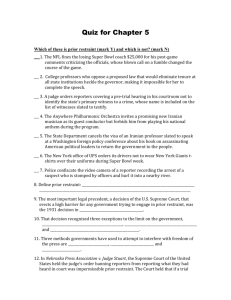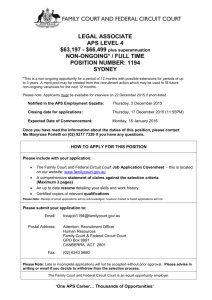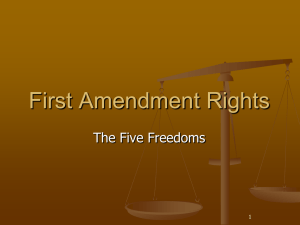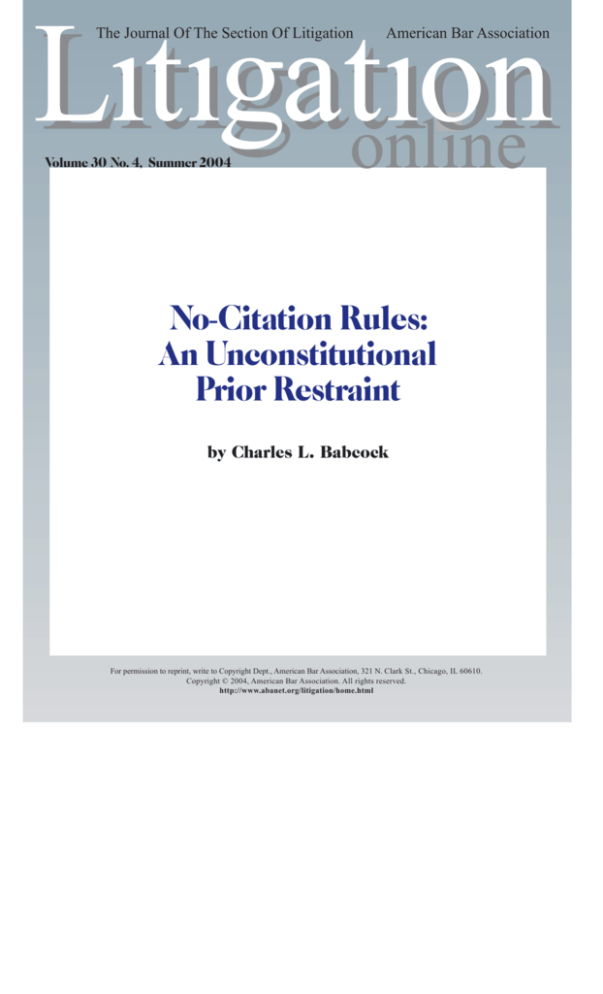
ıon
Lıtıgatonline
The Journal Of The Section Of Litigation
American Bar Association
Volume 30 No. 4, Summer 2004
No-Citation Rules:
An Unconstitutional
Prior Restraint
by Charles L. Babcock
For permission to reprint, write to Copyright Dept., American Bar Association, 321 N. Clark St., Chicago, IL 60610.
Copyright © 2004, American Bar Association. All rights reserved.
http://www.abanet.org/litigation/home.html
Lıtıgatıon online
http://www.abanet.org/litigation/home.html
No-Citation Rules:
An Unconstitutional Prior Restraint
by Charles L. Babcock
There are court rules in four federal circuits and more than 25
states that prohibit citation to unpublished decisions of those
courts. These “no citation rules” have generated much controversy in the past three years. A recent position paper from
the American College of Trial Lawyers (ACTL) observes:
“Courts are declining to publish opinions that turn out to be
the best authority in a given setting, then refusing to talk about
them or permit their discussion. For a court to blind itself, in
advance, to the persuasive power of its own reasoning simply
makes no sense.” See Opinions Hidden, Citations Forbidden:
A Report and Recommendations, 208 F.R.D. 645, 647 (2002),
available at www.actl.com/PDFs/Opinions.pdf. On the other
hand, in his January 16, 2004, Comment to the Advisory
Committee on Appellate Rules, U.S. Circuit Judge Alex
Kozinski defends the no-citation rule as “an important tool in
the fair administration of justice,” arguing that “its removal
will have serious adverse consequences for the court and the
parties appearing before it.” Kozinski Comment at 21.
In the past two years, several state courts and federal circuits have either modified or abolished their no-citation rules.
The Advisory Committee on Appellate Rules for the Committee on Rules of Practice and Procedure of the Administrative Office of the U.S. Courts (Advisory Committee) has proposed Rule 32.1, which would prohibit the federal circuits
from imposing a restriction “upon the citation of judicial
opinions, orders, judgments, or other written dispositions that
have been designated as unpublished, not for publication,
non-precedential, not precedent, or the like.” When the comment period for this proposed rule closed on February 16,
2004, more than 400 comments had been received. More than
90 percent of the commentators were opposed to the proposed
rule that would abolish no-citation rules in the four federal
circuits where they currently exist.
On April 14, 2004, the eight-member Advisory Committee
voted, with only one dissent, to endorse the proposed rule.
The proposal still faces obstacles, including approval by the
U.S. Judicial Conference and the U.S. Supreme Court. Thus,
the future of Rule 32.1 is still in question, and the debate can
be expected to continue.
The Advisory Committee memorandum, which analyzed
the proposed rule prior to the comment period, noted that nocitation rules may be unconstitutional under the First Amendment as prior restraints. There was no extended discussion of
this point, and it has received scant attention in the comments.
Indeed, only a few of the public commentators to Rule 32.1
mentioned this issue, and then only in passing. Judge Kozinski, a staunch defender of the no-citation rules, labeled the
First Amendment argument “foolish,” arguing, “It is inconceivable that the issue would not have been litigated and
resolved by now—if there were really a colorable First
Amendment claim to be made.” See Kozinski Comment at 20.
There is, in fact, no case that has considered or decided this
issue, although Judge Kozinski himself had the opportunity to
address the matter in Hart v. Massanari, 266 F.3d 1155 (9th
Cir. 2001), when the Ninth Circuit issued a show cause order
to an appellate lawyer who had cited an unpublished decision
in violation of that court’s rule. In approving the court’s rule,
Judge Kozinski focused on the constitutionality of denying
precedential effect to a prior unpublished decision, not on
whether First Amendment issues are raised by a sanction on a
litigant who merely cites a prior opinion of the court. The failure to address the issue provoked some criticism.
The prior restraint issue is substantial and has led prestigious organizations such as the ACTL and commentators to
conclude that the no-citation rules cannot stand under the First
Amendment. If this conclusion is correct, proposed Rule 32.1
is constitutionally compelled.
Charles L. Babcock is a partner at Jackson Walker L.L.P. in Dallas and
Houston, Texas, and chair of the Texas Supreme Court advisory committee
that recommended abolishing the Texas rule prohibiting citation to unpublished opinions. Mr. Babcock wishes to thank Texas Supreme Court Associate
Justice Nathan Hecht; Chris Griesel, rules attorney for the Texas Supreme
Court; and Tania Hepfner, Desiree Killen, Kathy Adair, and Caren Luckie at
Jackson Walker for their contributions to this article.
Litigation Summer 2004
2
Volume 30 Number 4
Lıtıgatıon online
http://www.abanet.org/litigation/home.html
It is worth looking at the history of no-citation rules to put
this controversy in context. The current no-citation rules in
the federal system are only 30 years old. They were developed
as an adjunct to the concern that too many opinions were
being printed and published and that “the common law of the
United States court would be crushed by its own weight if the
trends continued unabated.” See Note, “Anastasoff v. United
States; Uncertainty in the Eighth Circuit—Is There a Constitutional Right to Cite Unpublished Opinions,” 54 Arkansas
Law Review 847, 857-60 (2002). The board of the Federal
Judicial Center recommended that the Judicial Conference
direct each circuit counsel to review its publication policy and
implement certain modifications. By 1974, each federal circuit had adopted its own unique plan for limiting publication
of opinions, and each had some form of no-citation rule.
From the beginning, the circuits split on how to deal with
citation of unpublished opinions. Some permitted citation, others disfavored the practice, and others flatly prohibited it. In
1994 the Tenth Circuit abolished its no-citation rule, and
within the last three years the D.C. and First Circuits have
modified their rules. But by 2004, it has been argued, “the
existing circuit by circuit patch work is confusing, perilous,
and getting worse.” ACTL Recommendations, 208 F.R.D. at
647. Now only the Second, Eighth, Ninth, and Federal Circuits
have no-citation rules. Proposed Rule 32.1 is an effort to bring
uniformity to the system where experimentation once was
thought to be valuable. The rule squarely raises the prior
restraint issue because it is, by design, limited only to the issue
of citation. It takes no position on and does not address the epicenter of the debate over unpublished opinions, i.e., whether
an unpublished judicial work is, or should be, precedential.
a prohibition of specific speech; (ii) by the judicial branch of
government acting in its rule-making role; (iii) prior to publication; and (iv) punishable by judicial sanctions, including
contempt. See, e.g., Near v. Minnesota, 283 U.S. 697 (1931);
Nebraska Press Ass’n v. Stuart, 427 U.S. 539 (1976). Thus, if
a citizen, through an attorney or as a pro se litigant, wishes to
provide the government with a truthful report of a prior public proceeding, deemed by the citizen to be important because
it relates to a governmental function (the results or ongoing
conduct of a lower court proceeding), the citizen may not do
so without fear of sanction.
Some courts refuse to review the validity of court rules
under a prior restraint analysis on the theory that the court is
acting in a legislative rather than a judicial role. Nevertheless,
even courts that refuse to characterize court rules restraining
speech as prior restraints acknowledge that “court rules must
endure even closer scrutiny than a legislative restriction” and
that “rules [that] have some of the inherent features of ‘prior
restraints’ have caused the judiciary to review them with particular care.” Chicago Council of Lawyers v. Bauer, 522 F.2d
242, 248 (7th Cir. 1975). In Bauer, the Seventh Circuit held
that a court rule that denied a lawyer his First Amendment
rights “must be neither vague nor overbroad” and that “the
limitation of First Amendment freedoms must be no greater
than is necessary or essential to the protection of the particular governmental interest involved.”
Conversely, other courts applying First Amendment analysis
to court rules restricting speech by attorneys on behalf of their
clients do apply a prior restraint analysis. United States v.
Salameh, 992 F.2d 445, 447 (2d Cir. 1993), for example, held:
Though the speech of an attorney participating in judicial proceedings may be subjected to greater limitations
than could constitutionally be imposed on other citizens
. . . the limitations on attorney speech should be no
broader than necessary to protect the integrity of the
judicial system and the defendant’s right to a fair trial.
In Seattle Times v. Rhinehart, 467 U.S. 20, 28 (1984), the
U.S. Supreme Court considered whether a rule of civil procedure was a “prior restraint on free expression” and therefore
subject to a “heavy burden of justification.” The Court found
that a state rule prohibiting dissemination of information
obtained through the discovery process before trial “is not the
kind of classic prior restraint that requires exacting First
Amendment scrutiny.” Instead, the Court applied a far less
demanding standard: “whether the ‘practice in question [furthers] an important or substantial government interest unrelated to the suppression of expression’ and whether ‘the limitation of First Amendment freedoms [is] no greater than is
necessary or essential to the protection of the particular government interest involved.”’
The Court found that the rule, which was similar to Federal
Rule of Civil Procedure 26(c), permitted protective orders
that furthered a substantial government interest of entitling
litigants to obtain information relevant to the case and allowing them to prepare for trial. It also permitted broad discovery
and compelled sometimes unwilling parties to the litigation
(the defendants) to reveal information that, in the case before
Prior Restraint
Rule 32.1 does not require a court to issue an unpublished
opinion or prevent a court from doing so. It takes no position
on the constitutionality or even advisability of issuing unpublished decisions. According to the Advisory Committee,
“[T]he one and only issue addressed by proposed Rule 32.1 is
the ability of parties to cite opinions designated as ‘unpublished’ or ‘non-precedential.’” See Report of Advisory Committee on Appellate Rules (Advisory Committee Report),
May 23, 2003, at 27.
The debate over whether unpublished opinions were precedential was set off by the Eighth Circuit’s opinion in Anastasoff v. United States, which held that Article III of the Constitution required the court to give precedential effect to a prior
unpublished opinion. 223 F.3d 898, vacated as moot on reh’g
en banc, 235 F.3d 1054 (8th Cir. 2000). The Ninth Circuit in
Hart and the Federal Circuit in Symbol Technologies v. Lemelson Medical, 277 F.3d 1361 (Fed. Cir. 2002), took sharp
exception to this ruling.
There has, however, been no discussion in the cases
whether a no-citation rule is a prior restraint. Yet that goes to
the heart—if not the Hart—of any proposed sanction on a litigant who seeks to tell a court what it has done before in violation of a rule prohibiting him from doing so.
No-citation rules bear all the indicia of a prior restraint: (i)
Litigation Summer 2004
3
Volume 30 Number 4
Lıtıgatıon online
http://www.abanet.org/litigation/home.html
the Court, was sensitive and perhaps even constitutionally
protected, e.g., membership lists. The unanimous Supreme
Court concluded that because the protective order was made
on a finding and showing of good cause, as required by the
rule; was limited to the context of pretrial discovery; and did
not restrict the dissemination of information that came from
other sources, the First Amendment was not offended.
The Supreme Court’s decision in Seattle Times considered
a rule in a context far different from the no-citation rules. It is
one thing for the government to set up a system whereby parties to litigation are compelled to reveal sensitive information
only upon the promise that the information will be protected
through the pretrial process, but quite another when the rules
restrain speech about a public (in the sense that it is available)
body of work—the writings of the various judges themselves
deciding cases in a common law system.
Still, participants in litigation are subject to greater
restraints than others. In Gentile v. State Bar of Nevada, 501
U.S. 1030 (1991), the U.S. Supreme Court decided whether
an attorney’s extrajudicial comments in a criminal trial violated a state bar disciplinary rule and could be punished consistent with the First Amendment. The Court reversed the
lawyer’s conviction for statements made at a press conference, holding that the rule in question was void for vagueness.
But in reaching this decision, the Court, in dicta, stated: “It is
unquestionable that in the courtroom itself, during a judicial
proceeding, whatever right to ‘free speech’ an attorney has is
extremely circumscribed. An attorney may not, by speech or
other conduct, resist a ruling of the trial court beyond the
point necessary to preserve a claim for appeal.” Id. at 1073.
Even though the appellate advocate is in “a courtroom,” he
is not in the same setting as an “emotionally charged criminal
prosecution,” as was the lawyer in Gentile or even in a run-ofthe-mill civil trial. Rather, the appellate advocate is a part of a
proceeding that contains numerous speech-neutral restraints
on his participation. Typically, the advocate has 20 to 30 minutes to say what he deems is important for the appellate court,
and his written product is typically circumscribed in a number
of speech-neutral ways such as page limits, margin requirements, and font specifications. By contrast, a trial is a more
lengthy proceeding, considerably less scripted, and often with
factfinders (the jury) unfamiliar with the judicial process. Add
to that mix our adversary system, which “presupposes, or at
least stimulates, zeal in the opposing lawyers,” and you have
a proceeding that “can pervert as well as aid the judicial
process unless it is supervised and controlled by a neutral
judge representing the overriding social interest in imparting
justice and with the power to curb both adversaries.” Sacher
v. United States, 343 U.S. 1, 8 (1952).
No-citation rules have less kinship with the lawyer speaking during a trial than they have with the lawyer or litigant
who, as stated in Gentile, “has a constitutional freedom of
utterance and the ability to exercise it to castigate courts and
their administration of justice,” which the Supreme Court
suggests is fully protected First Amendment speech. 501 U.S.
at 1073. After all, the no-citation rules implicate a citizen’s
ability to bring to the court, again with various speech-neutral
limits, what was wrong with the lower court decision or what
Litigation Summer 2004
another court had to say about a similar situation.
Even when speech restrictions are placed on the lawyer in
pending or ongoing trials, and even when the statements are
in the courtroom, courts have “engaged in a balancing
process, weighing the State’s interest in the regulation of a
specialized profession with a lawyer’s First Amendment
interest in the kind of speech that was at issue.” Id. at 1074.
Zal v. Steppe, 968 F.2d 924 (9th Cir. 1992), is a case in
point. There, an attorney was prohibited from presenting certain defenses or saying specific words that would have violated a motion in limine granted by the trial court. It is hard to
imagine a more unsympathetic First Amendment argument in
light of Gentile’s dictum that an attorney may not resist a ruling of a trial court beyond the point necessary to preserve a
claim for appeal.
The Ninth Circuit, however, gave careful attention to the
trial advocate’s claim. Indeed, the decision affirming the
trial court’s order holding the lawyer in contempt was split,
with each panel member writing an opinion. One of the
panelists dissented, although the majority held that the trial
court’s evidentiary order did not infringe the lawyer’s rights
to preserve his client’s right to appeal and therefore the
“In the courtroom,
whatever right to ‘free
speech’ an attorney has is
extremely circumscribed.”
orders did not violate the First Amendment. Judge Noonan,
dissenting in part, noted that the justification for prohibiting outbursts in court by jurors, witnesses, or spectators
was supported by the compelling governmental need not to
disrupt the trial. But he noted that “regulation of lawyers’
speech presents a problem that requires much finer analysis
when the intent of the lawyer speaking is to serve the client
who is on trial.” 968 F.2d at 936.
Finally, we come to two recent U.S. Supreme Court decisions dealing with related First Amendment issues. The first,
Legal Services v. Velazquez, 531 U.S. 533, 545 (2001), concerned a statute that prohibited use of legal services funds to
challenge existing welfare laws. The law was struck down
because it was “inconsistent with the proposition that attorneys should present all the reasonable and well-grounded
arguments necessary for proper resolution of the case.” Then
there is Republican Party of Minnesota v. White, 536 U.S. 765
(2002), where Justice Scalia wrote that the First Amendment
did not permit the Minnesota Supreme Court to prohibit candidates for judicial election in that state from announcing their
views on disputed legal and political issues.
Although neither case was decided on prior restraint
grounds, both are instructive. In Velazquez, Justice Kennedy,
4
Volume 30 Number 4
Lıtıgatıon online
http://www.abanet.org/litigation/home.html
writing for seven members of the Court, felt that the restriction imposed by the statute would result in two tiers of cases.
In the first, where Legal Services corporate counsel were
attorneys, there would be lingering doubt about whether the
truncated representation had resulted in complete analysis of
the case, full advocacy for the client, and proper presentation
to the court. The Court found, “The statute is an attempt to
draw lines around the LSC program to exclude from litigation
those arguments and theories Congress finds unacceptable but
which by their nature are within the province of the courts to
consider.” 531 U.S. at 546. The First Amendment, the Court
noted, was “fashioned to assure unfettered interchange of
ideas for the bringing about of political and social changes
desired by the people.” Id. at 548.
cannot deny litigants and the bar the right to urge upon us
what we have previously done.”
The chief judge of the Tenth Circuit, in questioning his
court’s now-abandoned no-citation rule, wrote:
No matter how insignificant a prior ruling might appear
to us, any litigant who can point to a prior decision of the
court and demonstrate that he is entitled to prevail under
it should be able to do so as a matter of the essential justice and fundamental fairness. To deny a litigant this
right may well have overtones of a constitutional
infringement because of the arbitrariness, irrationality,
and unequal treatment of the rule.
In re Rules of the U.S. Court of Appeals for the Tenth Circuit,
955 F.2d 36, 37 (1992) (Holloway, C.J. dissenting).
Even U.S. Supreme Court Justice Stevens criticized the nocitation rules when he wrote in dissent in County of Los Angeles v. Kling, 474 U.S. 936, 938 (1985) (mem.):
As this Court’s summary disposition today demonstrates, the Court of Appeals would have been well
advised to discuss the record in greater depth. One reason it failed to do so is that the members of the panel
decided that the issues presented by this case did not
warrant discussion in a published opinion that could be
“cited to or by the court of this circuit”. . . That decision
not to publish the opinion or permit it to be cited—like
the decision to promulgate a rule spawning a body of
secret law—was plainly wrong.
In Williams v. Dallas Area Rapid Transit, 256 F.3d 260
(5th Cir. 2001) (Smith, J. dissenting), Judge Smith of the
Fifth Circuit noted, “This court’s primary asserted justification for issuing unpublished opinions is efficiency,” adding,
“Indeed, efficiency may be the only justification for the
practice of issuing unpublished opinions, but one that cannot be gainsaid.” Judge Kozinski issues a more elaborate
justification. Noting that briefs and other court papers are
not public forums, he observed, “[W]e apply all manner of
restrictions . . . that can never be applied to other types of
speech.” See Kozinski Comment at 20. These restrictions,
he says, are needed to ensure the fair administration of justice. He argues that the judges of the Ninth Circuit Court of
Appeals believe that citations to their unpublished opinions
would be misleading if used in briefs because, he says,
some decisions of the Ninth Circuit are prepared by staff
attorneys, with the judges themselves spending only “five
to ten minutes” on the case. In other instances, he reveals
the “open secret” that judicial law clerks (typically recently
graduated law students) prepare the opinions with minimum input from the judges. Id. at 5-6.
As one who clerked for a federal judge (albeit a long time
ago), I know that it is not much of a secret that law clerks and
staff counsel do much of the writing for the courts. Of course,
that varies from chamber to chamber, but nonetheless, Judge
Kozinski is entirely accurate when he notes the heavy
involvement of young lawyers in the writing process. But
whether a non-judicial appointee in the federal system or a
non-elected judge in the state system (the clerks) actually
wrote the words, or “spent a lot of time” on the opinion, seems
Justifications
In no-citation jurisdictions, a substantial body of law, annually 80 percent of the decisions in the federal courts of
appeals, may not be used to bring about change. In other
words, a substantial body of law, dating back 30 years, may
not be discussed in no-citation jurisdictions. Whatever First
Amendment standard is applied and whether or not it is
labeled a prior restraint, the rules bear some burden of justification as they restrict a substantial amount of important
speech. The importance of the speech consistently has been
noted by the U.S. Supreme Court, for example, in Nebraska
Press Association v. Stuart, 427 U.S. 539, 559 (1976): “Truthful reports of public judicial proceedings have been afforded
special protection against subsequent punishment.” To be
sure, there may be an interest, compelling or otherwise, that
dictates the suppression of this speech, but, as we shall see, no
justification that has been advanced is weighty enough to
infringe on the litigant’s First Amendment rights.
For example, the Advisory Committee Report, at 32, noted:
It is difficult to justify prohibiting or restricting the citation of “unpublished opinions.” Parties have long been
able to cite in the Courts of Appeals an infinite variety of
sources solely for their persuasive value. These sources
include the opinions of federal district courts, state courts
and foreign jurisdictions, law review articles, treatises,
newspaper columns, Shakespearean sonnets and advertising jingles. No Court of Appeals places any restrictions
on the citation of these sources . . . Parties are free to cite
them for their persuasive value, and Judges are free to
decide whether or not to be persuaded. There is no compelling reason to treat “unpublished” opinions differently.
It is difficult to justify a system under which the unpublished opinions of the D.C. Circuit can be cited to the Second Circuit, but the unpublished opinions of the Second
Circuit cannot be cited to the Seventh Circuit. And more
broadly it is difficult to justify a system that permits parties to bring to a court’s attention virtually every written
or spoken word in existence except those contained in the
court’s own “unpublished” opinion.
In Jones v. Superintendent, Virginia State Farm, 465 F.2d
1091, 1094 (4th Cir. 1972), the Fourth Circuit acknowledged
that “any decision is by definition our precedent, and . . . we
Litigation Summer 2004
5
Volume 30 Number 4
Lıtıgatıon online
http://www.abanet.org/litigation/home.html
a flimsy justification for restricting a litigant’s rights to bring
the court’s own words before it. In the end, it is the court that
endorses the words and performs a governmental function of
ordering the rights of the parties in the case. What if it is
learned that judges deciding a case had only slight involvement in drafting a published opinion? Can the lack of substantial judicial involvement be brought to the attention of the
court to reduce the precedential value of the opinion?
It seems that the better practice is to cite the unpublished
opinion because it is persuasive on a point of law that is
important for the disposition of this case. The no-citation rules
make no judgment about whether or not the prior unpublished
opinion is precedent. But if a litigant wants to waste precious
brief and argument time and space on authority, shouldn’t that
decision rest with the litigant and his counsel?
Judge Kozinski’s argument that the no-citation rule does
not offend the First Amendment because the courtroom where
the unpublished opinion might be cited is not a public forum
is beside the point. The public forum issue relates to access to
government buildings, not to what speech is permissible
court judges in their courtrooms, by our panels in later
cases, and by lawyers advising clients about the likely
consequences of various courses of actions.
He adds, “Appellate courts . . . have to speak with a consistent
voice and, if they failed to do so—if they leave the law uncertain or in disarray—they will make it very difficult for
lawyers to advise their clients and for lower court judges to
decide cases correctly.” Id. at 31. Further, “If unpublished
decisions could be cited as precedent, conscientious judges
would have to pay much closer attention to their precise
wording.” Id. at 34.
Rule 32.1, however, makes no recommendation regarding
whether or not unpublished opinions should be precedent.
Indeed, the Ninth Circuit can continue to treat its unpublished
opinions as nonbinding. The First Amendment question, however, is whether a citizen may be prevented from using the
precious space (in the brief) and time (at oral argument) to
urge upon the court an unpublished opinion. There is an obvious disincentive to do so. Citing an unpublished opinion is a
tacit (sometimes express) admission that the advocate can
find no published opinion to support the case. Nevertheless,
the advocate may see a value in citing the case for its persuasive reasoning, presumably on similar facts.
Judge Kozinski, who amplified his congressional remarks
in his written comments to the Advisory Committee, charged
that citing to an unpublished opinion is fraudulent. He argues
that citing a law review article is different from citing a prior
unpublished opinion of the court because the party seeking to
cite the unpublished opinion wants “the added boost of claiming that three court of appeals judges endorse that reasoning.”
See Kozinski Comment at 4.
The ACTL had this to say about Judge Kozinski’s “fraud”
argument:
The argument is unworthy of its distinguished author. Circuit judges—the hypothetical recipients of the hypothetically fraudulent representation—are not about to be gulled;
they know better than anyone the limitations of non-circuit
binding opinions. Indeed, if there is that imbalance of
knowledge that is generally thought to be the badge of
fraud, it is in this instance the recipients who have the better knowledge. The court decided the cited case, and members of the court knew all the facts in the record; the citing
lawyer knows only what the Westlaw or Lexis opinion tells
him. Even in anti-citation circuits, as we have seen, the
judges themselves cite the non-reporter published opinions
of other circuits when they are thought to have persuasive
value; the lawyer is doing no more.
ACTL Recommendation at 34.
Judge Kozinski also took the Advisory Committee to task
by noting that, unlike law review articles, opinions of district
courts, and other nonbinding authorities, unpublished dispositions of the circuit are seldom dismissed as inconsequentially as they should be. Kozinski Comment at 3. Of course,
law review articles written by distinguished judges, such as
Judge Kozinski, can be cited and “are seldom dismissed as
inconsequential” because a judge of the circuit (perhaps even
one on the panel deciding a case) has expressed a view. For
The no-citation rules
are unconstitutional,
and Rule 32.1 is
constitutionally compelled.
within them. It has been held (although not definitively so)
that a judicial complex is not a public forum. Sammartano v.
First Judicial District Court, 303 F.3d 959 (9th Cir. 2002).
Restrictions on free expression in a non-public forum are subject to a relaxed standard under which the restrictions are constitutional if the distinctions drawn are (1) “reasonable in light
of the purpose served by the forum” and (2) viewpoint-neutral. Cornelius v. NAACP Legal Defense & Education Fund,
473 U.S. 788, 806 (1985). The public forum analysis, however, seems inapposite here. No-citation rules do not implicate access to the courthouse. The parties to litigation or
appeal surely have a right of access. Nor are we discussing
restrictions on their right to attend by wearing or not wearing
certain clothing, as was the case in Sammartano, or their
political viewpoint, as was the case in Cornelius. We are talking here about what is said in the building or in the briefs that
are filed in the building, not about gaining access to it.
In testimony before the House of Representatives Committee on the Judiciary on June 27, 2002 (Kozinski Testimony),
Judge Kozinski proposed an additional justification for nocitation rules:
Prohibiting citation to, and reliance on, unpublished dispositions helps our court to maintain consistency and
clarity in the law of the circuit—law applied by lower
Litigation Summer 2004
6
Volume 30 Number 4
Lıtıgatıon online
http://www.abanet.org/litigation/home.html
example, I would suspect that an appellate advocate would be
hesitant to cite an unpublished opinion to a panel consisting
of Judges Kozinski and Reinhardt (who wrote a law review
article on the subject), although she might want to cite their
article (and could do so). But that is just a guess.
Finally, Judge Kozinski suggests that the proposed rule
would increase the burden on lawyers and the cost to their
clients, and impose severe disadvantages on poor and weak
litigants. As support for this, Judge Kozinski relies on a Yale
Law Journal article that argues that making all unpublished
decisions precedential would “disproportionately disadvantage litigants with the fewest resources.” Note, “Fairness and
Precedent,” 110 Yale L.J. 1295 (2001). But Rule 32.1 does not
make cases precedential, and the prior restraint argument does
not turn on this distinction. The Yale Law Journal article was
persuasively dissected by Professor Barnett in his comments
to the Advisory Committee.
Whether one applies the “heavy presumption against” standard of prior restraints law or the more lenient balancing test
discussed here, the no-citation rules are unconstitutional, and
Rule 32.1 is constitutionally compelled. There is no rational
justification sufficient to overcome the speech interests of our
citizens in citing public decisions of our government. The opinions are not private as in Rhinehart, they are not necessary to
maintain decorum in the courtroom as in Zal, they don’t impli-
Litigation Summer 2004
cate access to the public forum as in Sammartano, they don’t
implicate the right to a fair trial as in Gentile, they don’t deal
with whether or not the decision is precedent as in Hart and
Anastasoff, and they aren’t likely to defraud the court, which is
acutely aware of its workload and the extent to which law
clerks and staff do the writing. In short, there is no interest sufficient to overcome the litigants’ First Amendment interests.
And as for Judge Kozinski’s argument that “a small but
vociferous number of lawyers and litigants” are behind all this
trouble, Kozinski Comment at 1-2, I would differ. First, I
hardly would paint the ACTL as a bunch of rabble-rousers.
Yet their recommendation persuasively calls for the adoption
of Rule 32.1. And the Texas experience, of which I have personal knowledge, is instructive. The amendment to our appellate rule 47 was called for by members of the bar who petitioned the Texas Supreme Court for change. It was studied
and recommended by our Texas Supreme Court Advisory
Committee, consisting of lawyers and judges from around the
state. It was advocated by editorial writers in major newspapers throughout the state and ultimately was accepted by the
bench and bar with little dissent. In other words, at least in one
large state, there was consensus, not advocacy from “a small
but vociferous group of lawyers.” Despite the outpouring of
sentiment from certain judges and lawyers against Rule 32.1,
it should be adopted.
7
Volume 30 Number 4

